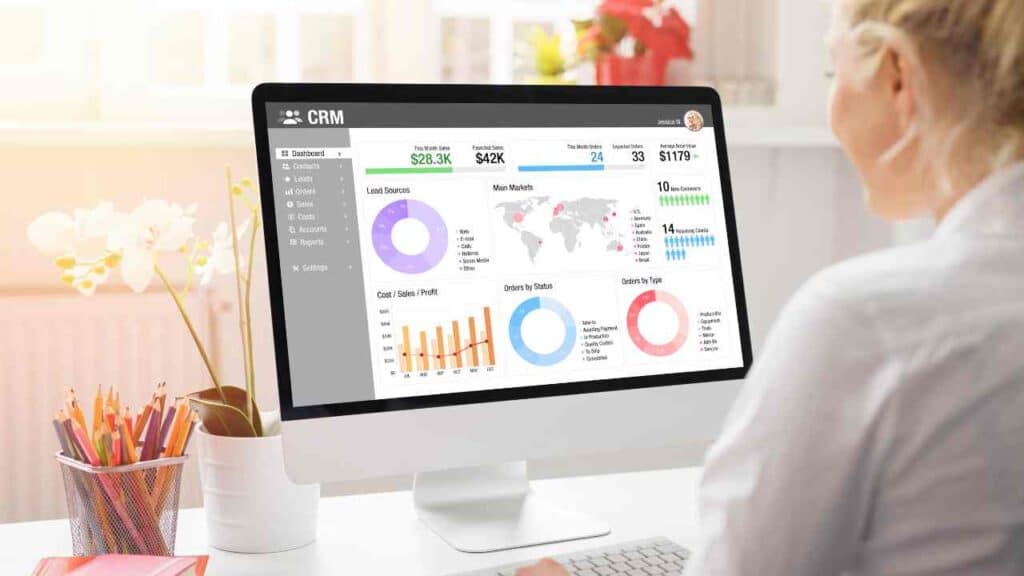Utilizing CRM to Facilitate Employee Collaboration

Effective collaboration among employees is crucial for the success of any organization. When employees work together seamlessly, they can achieve higher productivity, improved decision-making, and enhanced innovation. However, fostering collaboration can be challenging, especially in large organizations with dispersed teams. This is where Customer Relationship Management (CRM) systems come into play. By leveraging CRM tools, businesses can streamline communication, encourage knowledge sharing, and facilitate collaboration among employees. In this article, we will explore the benefits of utilizing CRM to facilitate employee collaboration and provide valuable insights on how businesses can effectively implement CRM systems to enhance teamwork and productivity.
The Role of CRM in Employee Collaboration
CRM systems are primarily designed to manage customer relationships and improve sales and marketing processes. However, their capabilities extend beyond customer management. CRM platforms can also serve as powerful tools for internal collaboration and knowledge sharing. By centralizing information and providing a unified platform for communication, CRM systems enable employees to work together more efficiently and effectively.
Here are some key ways in which CRM can facilitate employee collaboration:
- Centralized Communication: CRM platforms provide a centralized hub for communication, allowing employees to easily connect and collaborate with each other. Whether it’s through instant messaging, video conferencing, or project management tools integrated within the CRM, employees can communicate in real-time, regardless of their physical location.
- Shared Knowledge Base: CRM systems enable the creation of a shared knowledge base where employees can store and access important information. This eliminates the need for lengthy email threads or searching through multiple documents, making it easier for employees to find the information they need and collaborate more effectively.
- Task and Project Management: CRM platforms often include task and project management features that allow teams to assign tasks, set deadlines, and track progress. This ensures that everyone is on the same page and helps teams collaborate more efficiently towards common goals.
- Document Collaboration: Many CRM systems offer document collaboration capabilities, allowing employees to work together on shared documents in real-time. This eliminates the need for back-and-forth email exchanges and ensures that everyone has access to the latest version of a document.
Real-Life Examples of CRM-Enabled Collaboration
Several organizations have successfully utilized CRM systems to enhance employee collaboration. Let’s take a look at a few real-life examples:
Example 1: Company A
Company A, a global software development firm, implemented a CRM system to improve collaboration among its geographically dispersed teams. By utilizing the CRM’s centralized communication features, employees were able to connect and collaborate in real-time, regardless of their physical location. The shared knowledge base within the CRM allowed employees to easily access important project information, reducing the time spent searching for information and improving overall productivity. Additionally, the CRM’s task and project management capabilities enabled teams to effectively coordinate their efforts and meet project deadlines.
Example 2: Company B
Company B, a marketing agency, integrated a CRM system into its workflow to enhance collaboration between its sales and marketing teams. The CRM’s shared knowledge base allowed the sales team to provide valuable insights and feedback to the marketing team, enabling them to create more targeted and effective marketing campaigns. The CRM’s document collaboration feature also facilitated seamless collaboration between the two teams, ensuring that everyone had access to the latest marketing materials and sales collateral.
Implementing CRM for Employee Collaboration
Now that we understand the benefits of utilizing CRM for employee collaboration, let’s explore how businesses can effectively implement CRM systems to enhance teamwork and productivity:
1. Choose the Right CRM Platform
There are numerous CRM platforms available in the market, each with its own set of features and capabilities. It’s important to choose a CRM platform that aligns with your organization’s specific collaboration needs. Consider factors such as ease of use, integration capabilities, and scalability when selecting a CRM platform.
2. Provide Adequate Training
Implementing a new CRM system requires proper training to ensure that employees can effectively utilize its collaboration features. Provide comprehensive training sessions and resources to familiarize employees with the CRM platform and its functionalities. Encourage employees to ask questions and provide ongoing support to address any concerns or difficulties they may encounter.
3. Foster a Collaborative Culture
Implementing a CRM system alone is not enough to foster collaboration. It’s essential to create a culture that values and encourages collaboration among employees. Promote open communication, teamwork, and knowledge sharing within the organization. Recognize and reward collaborative efforts to motivate employees to actively participate in collaborative activities.
4. Customize the CRM to Fit Your Workflow
Every organization has unique workflows and processes. Customize the CRM system to align with your organization’s specific collaboration needs. Configure the CRM’s communication, task management, and document collaboration features to match your existing workflows. This will ensure that the CRM seamlessly integrates into your organization’s daily operations.
Utilizing CRM to facilitate employee collaboration offers numerous benefits for organizations. By centralizing communication, providing a shared knowledge base, and offering task and project management capabilities, CRM systems enable employees to work together more efficiently and effectively. Real-life examples have demonstrated the positive impact of CRM-enabled collaboration on productivity and innovation. To successfully implement CRM for employee collaboration, businesses should choose the right CRM platform, provide adequate training, foster a collaborative culture, and customize the CRM to fit their specific workflows. By leveraging CRM systems, organizations can unlock the full potential of their employees and achieve greater success in today’s competitive business landscape.
Visit https://SaasExpert.ca – Your All-In-One Sales and Marketing Platform for small businesses, agency owners, and marketers.
Learn more about “Maximizing Employee Cooperation Throught CRM” right here.
Frequently asked questions about Utilizing CRM to Facilitate Employee Collaboration.

How can CRM systems enhance teamwork among employees? 🤝
Answer: CRM systems are like the glue that holds different team members together! By centralizing customer data, everyone can access up-to-date information at any time, from anywhere. This means sales, marketing, and customer service teams can seamlessly collaborate without the risk of duplicated efforts or miscommunication. 🔄 Plus, with activity tracking and notifications, team members can jump in right where others left off, ensuring a smooth relay in the customer service race. 🏃♂️💼 CRM tools also often include integrated communication platforms, like chat or email, so colleagues can discuss customer-related issues in real-time, fostering a collaborative environment that’s both efficient and effective. 📈
What features should I look for in a CRM to support team collaboration? 🛠️
Answer: When scouting for a CRM with stellar collaboration features, keep your eyes peeled for these game-changers: a shared calendar for managing team activities and deadlines, document sharing capabilities for real-time data access and updates, and integrated messaging tools for quick communication. 📅📂💬 Task assignment and tracking features are a must, ensuring everyone knows their responsibilities and progress can be monitored collectively. 📌 And don’t overlook customizable dashboards – they give each team member a personalized overview of what’s important for their role, aligning individual efforts with the team’s goals. 🎯
Can CRM systems improve communication with remote or hybrid teams? 🌐
Answer: Absolutely! CRM systems are a remote team’s best friend. 🤗 They provide a virtual meeting ground where remote or hybrid team members can stay in the loop with customer interactions and team activities, no matter their location. 🌎 With cloud-based CRM solutions, updates are instant and accessible 24/7, bridging time zones and physical distances. Video conferencing integrations can also help maintain that face-to-face connection that’s so crucial for strong team dynamics. 🖥️👥 Plus, with collaboration tools embedded within the CRM, it’s easier to maintain clear and consistent communication, ensuring that every team member feels connected and engaged with their peers. 🤝✨
How does CRM encourage accountability among team members? ✅
Answer: CRM systems come with transparency as a standard feature. When actions and updates are logged, it creates a visible trail of who did what and when. 🕵️♂️ This means every team member can see their impact on the customer journey, and there’s a clear record of each person’s contributions – or lack thereof. Accountability is naturally fostered because everyone knows they’re part of a bigger picture and their efforts are on display. 🖼️ Task management features allow for setting clear expectations, and reporting tools enable management to monitor performance and give kudos to top performers, which can really boost morale and motivate the team! 📊👍
In what ways can a CRM facilitate knowledge sharing among employees? 📚
Answer: Knowledge is power, especially when it’s shared! A CRM acts as a central knowledge repository where all customer-related data and interactions are stored. 🗃️ This means that insights gained by one employee can easily be accessed and utilized by another. Think of it as a library that’s always open, with books that update themselves! 📖🔄 Features like shared notes, document storage, and a searchable database make it simple for employees to find the information they need and learn from the experiences of their colleagues. This not only speeds up the onboarding of new team members but also ensures that the collective wisdom of the team is preserved and utilized, fostering an environment of continuous learning and improvement. 🌱💡
- crm
- customer relationship management
- Utilizing CRM to Facilitate Employee Collaboration
- What is CRM Software?






